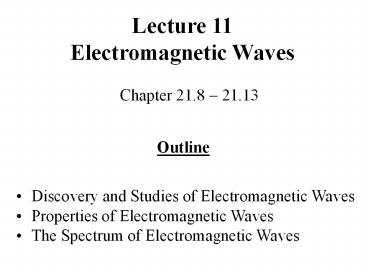Lecture 11 Electromagnetic Waves - PowerPoint PPT Presentation
Title:
Lecture 11 Electromagnetic Waves
Description:
Problem: An EM wave in vacuum has an electric field amplitude of 300 V/m. ... The ultraviolet light - beyond the blue end of rainbow ... – PowerPoint PPT presentation
Number of Views:86
Avg rating:3.0/5.0
Title: Lecture 11 Electromagnetic Waves
1
Lecture 11Electromagnetic Waves
Chapter 21.8 ? 21.13
Outline
- Discovery and Studies of Electromagnetic Waves
- Properties of Electromagnetic Waves
- The Spectrum of Electromagnetic Waves
2
Discovery of EM Waves
A changing magnetic field generates an electric
current ? electromagnetic induction.
J.C.Maxwell proposed that a changing electric
field has an associated magnetic field.
Such a combined effect results in existence of
electromagnetic waves, which can travel
indefinitely in empty space (vacuum). Electromagne
tic waves travel with the speed of light.
3
Properties of EM Waves
The electric and magnetic fields of a wave are
perpendicular to each other and to the travel
direction. EM waves are transverse waves. EM
waves travel with the speed of light (c). EM
waves carry both energy and momentum.
For an EM wave
1 c ??? ?(?0 ?0) 2.998
108m/s
Average power per unit area Emax Bmax
Emax2 c Bmax2 ???? ??? ??? 2 ?0
2 ?0 c 2 ?0
c E/B
4
Problem with EM waves
Problem An EM wave in vacuum has an electric
field amplitude of 300 V/m. Find the amplitude of
the corresponding magnetic field.
c E/B ? B E/c
B 300 V/m / 3 108 m/s 10?6 T 1 ?T
5
Properties of EM Waves
All EM waves travel through space with a speed c
? their wavelength ? and frequency f are related
? f c
Demonstration
The wavelength is the distance between adjacent
peaks of the electric or magnetic field 1 nm
(nanometer) 109 m 1µm (micron) 106 m The
frequency is the number of peaks that pass by any
point each second, measured in cycles per second
or Hertz (Hz). light demo
6
The Spectrum of EM Waves
The total variety of EM waves is called the
electromagnetic spectrum.
Different portions of the spectrum are called
Gamma rays ? the shortest wavelength light X rays
- wavelengths shorter than ultraviolet The
ultraviolet light - beyond the blue end of
rainbow The visible light - what we see with our
eyes The infrared light - beyond of the red end
of rainbow Radio waves - light with the longest
wavelengths
7
Electromagnetic spectrum
8
Electromagnetic spectrum
E energy h Planck constant ?
frequency
E h ?
9
Summary
- Electromagnetic waves are fluctuations generated
by moving charges that produce fluctuating
electric and magnetic fields. - Visible light is only a small portion of the
electromagnetic spectrum.































